Idea Light Bulb Dim Gif Funny
Smart LED bulbs that can be controlled by a hub or smartphone app are no longer a new idea. What is new is how far this technology has come since its advent just a few years ago. Also new: Products like the Nanoleaf Light Panels—a system of interlocking LED panels that let you decorate with light—fundamentally change the light-bulb concept.
Smart LED bulbs aren't quite a commodity, but they are getting close to maturity as far as the market goes. Today's bulbs are more compact, much brighter, have better color representation, and, for the most part, feature control apps that do more than ever and are easier to set up. Prices have also come down, with some no-name color-tunable bulbs now available for less than $10 each. (Buyer beware: You get what you pay for.)
This roundup considers several types of smart lighting fixtures as well as smart bulbs. Click this link if you're looking for our smart dimmer and switch reviews.
Updated May 13, 2022 to add a link to our Govee Glide Hexa Light Panels review. We admire Govee's modular light panels for their eye-catching design and variety of customizable animations, but the manufacturer cut a lot of corners compared to Nanoleaf's Shapes line, its obvious inspiration, and Govee's panels aren't much cheaper.
Best smart lighting for every situation
Philips Hue White and Color Ambiance — Best color smart bulb

Pros
- Bluetooth support eliminates the need for the Hue Bridge
- Excellent light quality and smooth dimming
- Hue ecosystem is unrivaled in terms of size and depth
- Supports Apple HomeKit ecosystem
Cons
- Philips Hue products are much more expensive than the competition
- Relying on Bluetooth limits you to 10 Hue devices
- You need the Hue Hub to assign Hue devices to rooms
Philips (now known as Signify) was one of the first players in this market, and the company's experience shows. The recent addition Bluetooth support obviates the need for the $60 Philips Hue Bridge (although most smart home denizens will want the Bridge anyway). Signify's Philips Hue lighting ecosystem is the industry's deepest and broadest, with bulbs of every shape and size imaginable, not to mention lighting fixtures landscape lighting.
Read our full Philips Hue White and Color Ambiance A19 (Bluetooth + Zigbee) review
Wyze Bulb Color — Best color smart bulb, runner-up
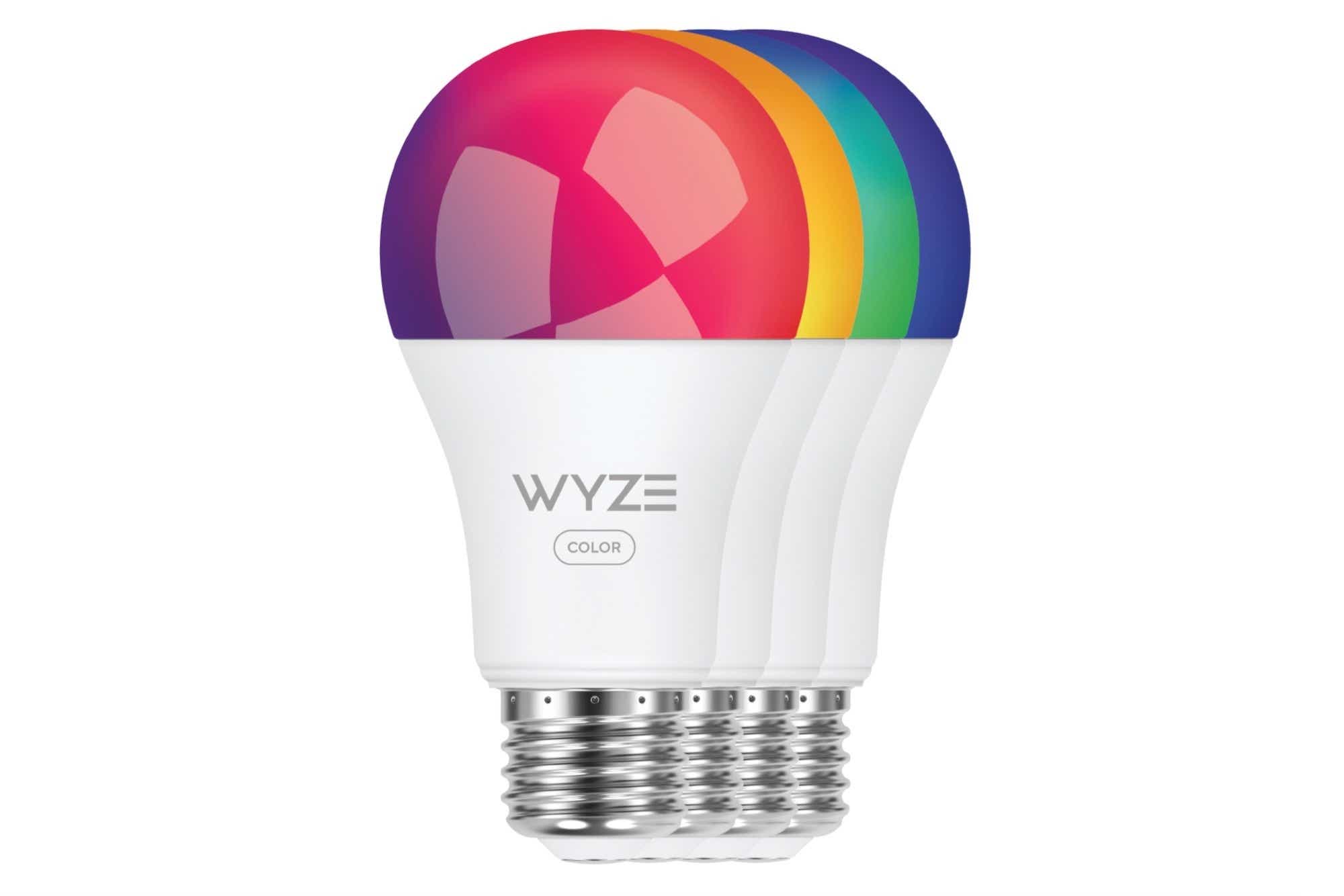
Pros
- Very inexpensive
- Connects via Wi-Fi or Bluetooth–no hub or bridge required
- Surprisingly bright considering the price
Cons
- Can't be grouped with the tunable white Wyze Bulb
- Only available as a 2- or 4-pack
- No competition for Philips Hue in terms of lighting ecosystem
Wyze Labs can't match Philips Hue in terms of the breadth of its smart lighting ecosystem, but it beats Signify's brand by a country mile in terms of pricing, and Wyze has a much broader array of product offerings when it comes to other areas of the smart home–most importantly in terms of home security.
Read our full Wyze Bulb Color review
Philips Hue White Ambiance A19 (Bluetooth + Zigbee) — Best white smart bulb
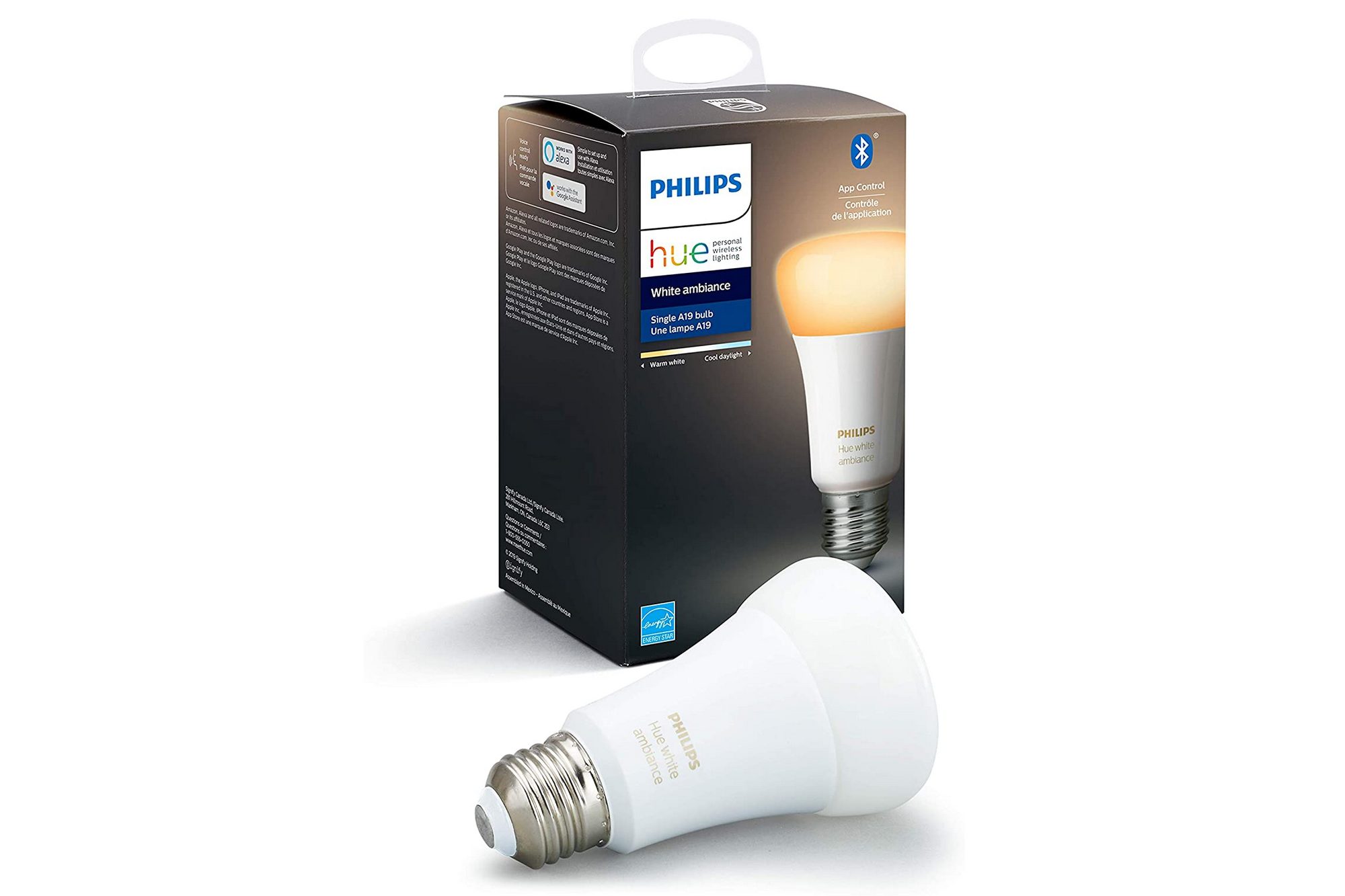
Pros
- Bluetooth support eliminates the need for the Hue Bridge
- Excellent light quality and smooth dimming
- Hue ecosystem is unrivaled in terms of size and depth
- Supports Apple HomeKit ecosystem
Cons
- Philips Hue products are much more expensive than the competition
- Relying on Bluetooth limits you to 10 Hue devices
- You need the Hue Hub to assign Hue devices to rooms
Our choice won't surprise anyone who's been following this market. Philips dominates this space and is also our top pick for best color LED smart bulb. The latest Hue bulbs can be controlled via Bluetooth or Zigbee (the latter requires the Philips Hue Bridge), they deliver high-quality light, and are backed by a strong warranty. We only received the BR30 form factor for our review, but apart from form factor, that bulb is the same as the A19.
Cree Lighting Connected Max Smart LED — Best budget smart bulb

Pros
- Very inexpensive
- Good quality light, plus colors
- No hub requirement
- Several other form factors in the Cree Connected Max family
Cons
- We experienced slight delays during our testing
- No Apple HomeKit support
We experienced a bit of stuttering sending commands to this budget-priced smart bulb, but you can't beat the price considering you get both tunable white and full color. Cree Lighting's Connected Max family includes a full range of form factors, too, including BR30, PAR38, vintage filament, tape lighting, and even retrofit downlights. It's not HomeKit compatible, but it does work with Siri Shortcuts.
Read our full Cree Lighting Connected Max Smart LED (Tunable White + Color Changing) review
Philips Hue Lightstrip Plus (2020) — Best LED light strip

Pros
- Bright and colorful
- Supports both Bluetooth and Zigbee
- Apple HomeKit compatible (with the Hue Bridge)
- Robust scheduling and automation features
Cons
- Much more expensive than competing products
- Power cable saddled with a chunky wall wart
- Lights can't be animated without a third-party app
The Philips Hue Lightstrip Plus makes for a great and easy way to add accent lighting to kitchen counters, stairways, and other indoor areas. The Philips Hue ecosystem is bigger than any other smart lighting solution, but Hue products are also much more expensive than the competition.
Read our full Philips Hue Lightstrip Plus (2020) review
TP-Link Kasa Smart Light Strip KL400L5 — Best LED light strip, runner-up
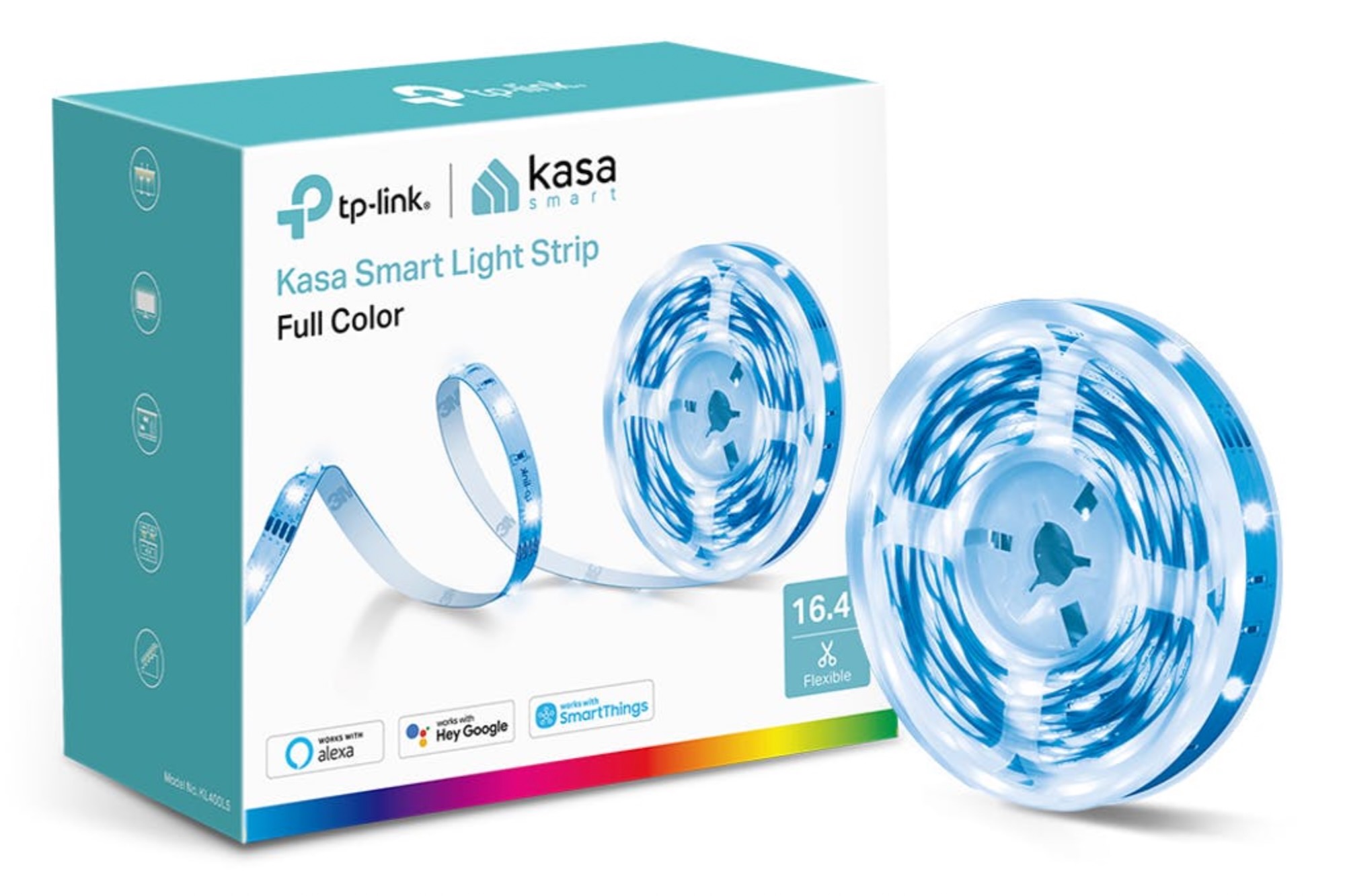
Pros
- Affordably priced
- Alexa, Google Assistant, and SmartThings integrations
- Solid collection of animated effects
- Plenty of scheduling, scene, and grouping options
Cons
- Cumbersome Wi-Fi setup
- Can't sync its LEDs with your music
- Flimsy construction
- Can't be extended with additional light strips
TP-Link built more features into this light strip than we expected for the price, and it even offers one feature that our top pick doesn't: animation sequences. The Philips Hue product, on the other hand, feels much more durable, and you can add extensions to the end of a strip. The biggest factor in TP-Link's favor? The price tag.
Read our full TP-Link Kasa Smart Light Strip KL400L5 review
Nanoleaf Shapes Hexagons — Most innovative lighting design

Pros
- Beautiful and interactive lighting scenes
- Touch actions let you control other smart devices
- Alexa, Google Assistant, Thread, and HomeKit compatible
- Surprisingly easy to install
Cons
- Panels can be difficult to remove from a wall (but don't appear to cause any damage)
- Chunky AC adapter
- Expensive
This is the first of Nanoleaf's Shapes interactive light panels, and it set the stage for several other equally fun versions. This modular lighting system won't illuminate a room–that's not it's intended purpose–but it can set a mood like nothing else on the market today.
Read our full Nanoleaf Shapes Hexagons review
Philips Hue Lily — Best outdoor spotlight
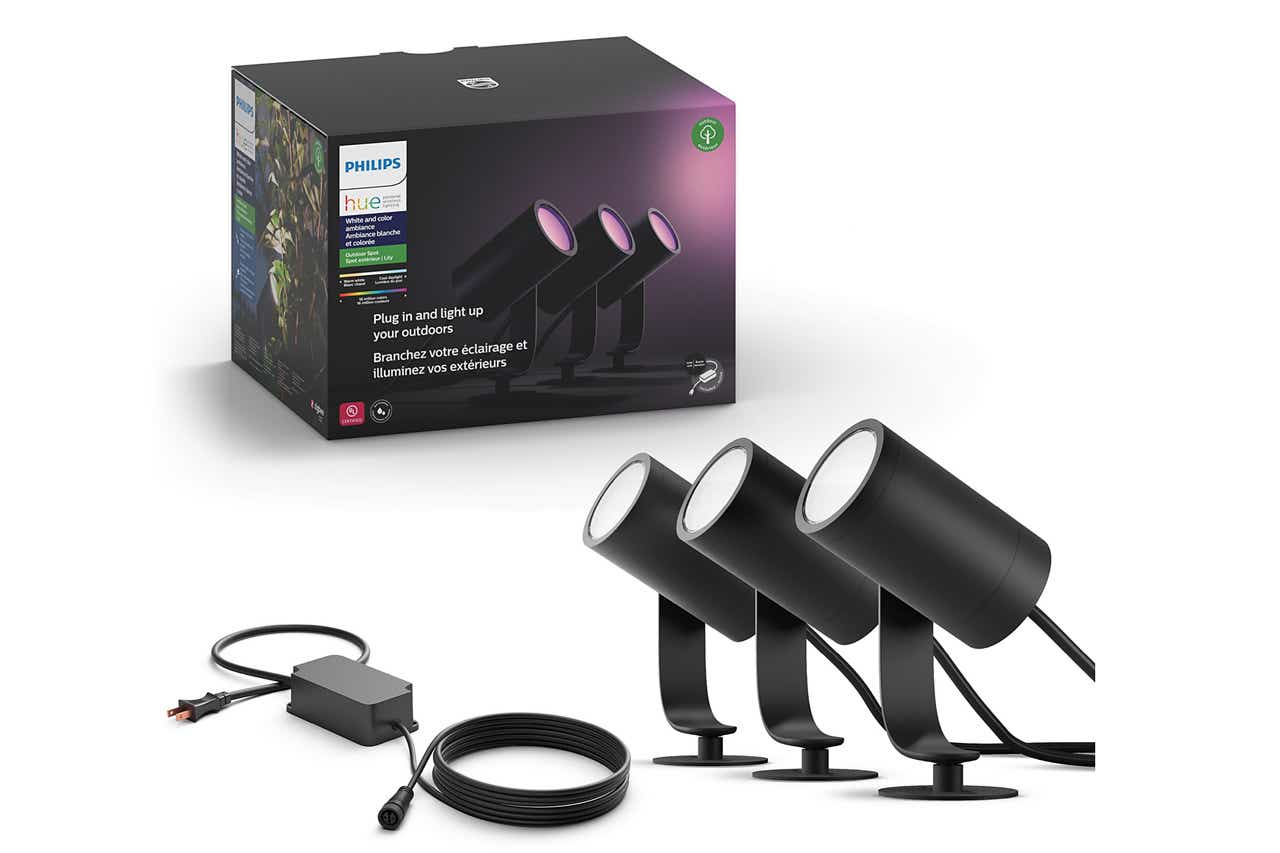
Pros
- Robust aluminum housing, glass lenses, and IP65 weatherization to withstand the elements
- Full color light, with up to 600 lumens of brightness
- Can be scheduled, controlled by Alexa or Google Assistant, and triggered by a Philips Hue Outdoor Sensor
- Low-voltage cables can be buried
Cons
- Requires Philips Hue Bridge
- Range is impacted by having the the Hue Bridge inside your home, hardwired to your router
- Expensive, and each add-on spotlight costs another $100
Signify's Philips Hue product line includes the most complete collection of outdoor and landscape LED lighting. In addition to the Lily spotlight, there's the Lily XL spotlight, the Calla Bollard light, the Econic Outdoor Pedestal, the Amarant linear outdoor light, no fewer than 9 wall or ceiling-mount outdoor lights, and even outdoor LED light strips. That diversity, and the high-quality design and construction of these luminaires, justifies Signify's high price tags.
Read our full Philips Hue Lily outdoor spotlight (3-spotlights and 1 power supply) review
Philips Hue Calla — Best outdoor pathway light

Pros
- 16 million of color, plus temperature-tunable white light
- Robust construction and protection from the elements
- A component in the broad Philips Hue lighting ecosystem
Cons
- Delivers only 600 lumens of brightness
- Must be hardwired to a plug-in power supply
- Very expensive compared to run-of-the-mill pathway lighting
The Philips Hue Calla outdoor pathway light adds sophisticated safety to outdoor walkways and patios, and Philips has the most complete smart lighting ecosystem in the industry. But you'll need an outdoor outlet to power this and all other Hue landscape lighting, and the components are very expensive.
Read our full Philips Hue Calla outdoor pathway light review
Ring Smart Lighting Solar Pathlight — Best outdoor pathway light, runner-up

Pros
- Battery powered with integrated solar panel
- Built-in motion sensor
- Can be integrated into the robust Ring home security ecosystem
- Once you have the bridge, add-on lights cost only $35
Cons
- Fabricated entirely from plastic
- Much more expensive than dumb pathlights
- Requires Ring Smart Lighting Bridge, which connects only to 2.4GHz Wi-Fi networks
Ring's smart lighting system isn't as broad as Signify's Philips Hue, but it covers the bases and it includes at least one feature the Hue ecosystem doesn't: lighting integrated with home security cameras. While we were initially concerned about the all-plastic housing, we've had one of the lights deployed for more than two years and haven't detected significant deterioration.
Read our full Ring Smart Lighting Solar Pathlight starter kit review
Enbrighten Wi-Fi Café Lights — Best outdoor string lights
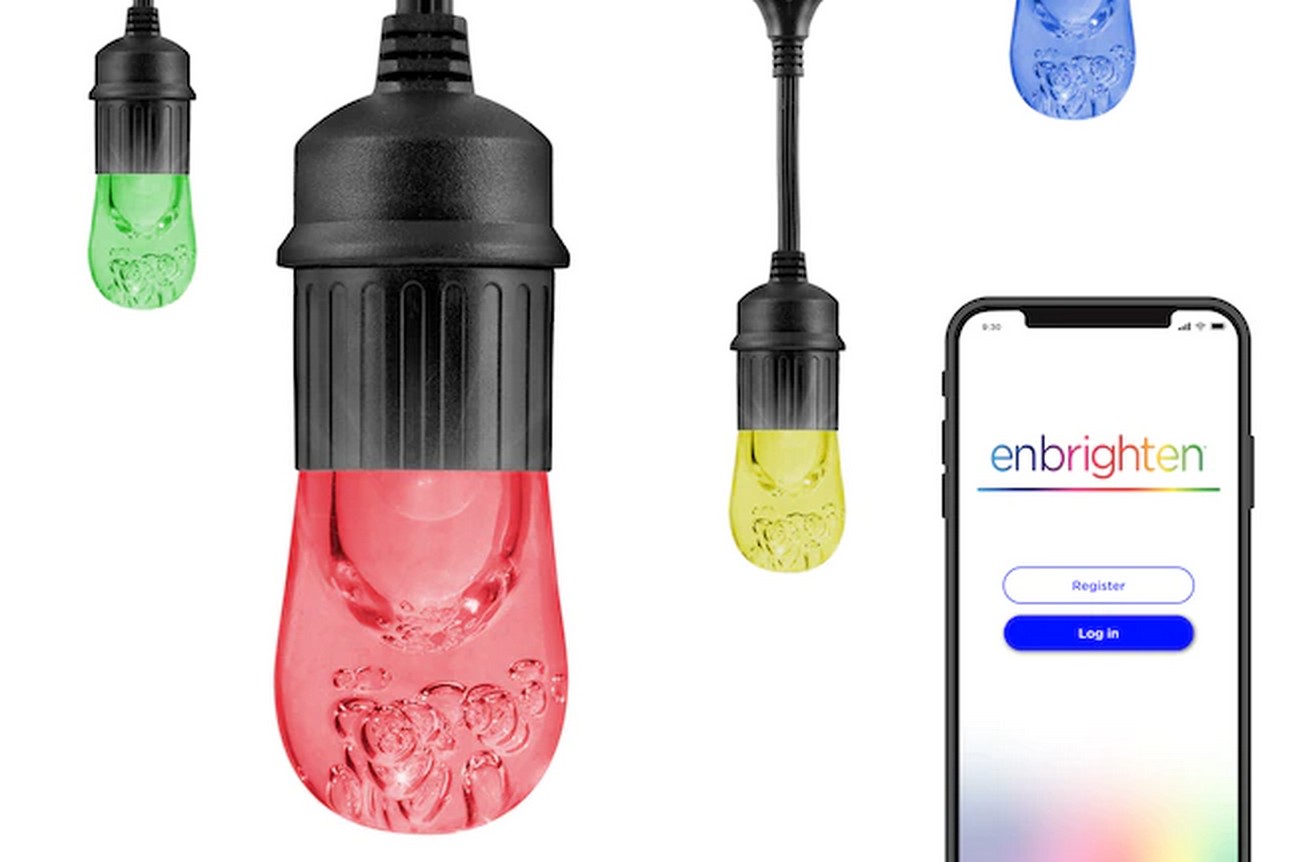
Pros
- Wi-Fi control, with Alexa and Google Assistant support
- Bright, vibrant colors, plus white light in six color temperatures
- Very good app with lots of customization and scheduling options
- Additional strings can be daisy-chained, up to 750 feet
Cons
- No IFTTT or Apple HomeKit compatibility
- Bulky control unit housing the power supply and Wi-Fi adapter
- Expensive compared to a plethora of "dumb" alternatives
Jasco's Enbrighten Wi-Fi Café Lights are certainly expensive, but they're also very pretty, highly customizable, and exceptionally durable for year-round outdoor installations. There's also surprisingly little competition in this admittedly specialized segment of outdoor lighting. Signify has outdoor Philips Hue light strips, for example, but that's a very different look from café-style lights.
Read our full Enbrighten Wi-Fi Café Lights review
White LED bulbs are smart, too
With their rainbow of hues and myriad party tricks, color LEDs get all the press in the world of smart lighting. It's fun stuff, but the reality is that most of us will rarely find much of a need to turn all the lights in the house blue or red—unless it's time to celebrate our team winning the World Series. Even then, you'll probably want to turn them all back to white after the celebration.
White light is also important in its own right, as today there is plenty of science to show how various shades of white—with variations in color temperature—impact our psychological state. Cool light that's closer to blue has an energizing effect, and is best in the morning. Warm light is relaxing, and is best after the sun goes down. Note, however, that not every white LED smart bulb is color-temperature-tunable. Check out the specs before you buy.
White smart bulbs downplay the party features that are a staple of color-tunable bulbs. On the other hand, white smart bulbs are less expensive than color bulbs, making it more affordable to roll them out in multiple rooms.
Smart lighting protocols and features
Three control technologies continue to vie for leadership in the smart bulb market (Z-Wave is a major contender in smart lighting, but you won't encounter it in bulbs—just in switches, plug-in modules, control panels, and smart-home hubs).
- Zigbee: Bulbs that use the popular smart-home networking protocol require a bridge to communicate with your home Wi-Fi network. This is the technology Philips has adopted for its Hue lineup, but it's not the only one.
- Wi-Fi: This class of bulb talks directly to your Wi-Fi router, no hub or bridge required. LIFX and TP-Link both manufacture excellent Wi-Fi smart bulbs, but neither company comes close to Signify's Philips Hue lineup in terms of the depth and breadth of the Hue ecosystem.
- Bluetooth: These bulbs skip your home network altogether and pair directly with your smartphone or tablet. As such, they can't be controlled from outside your home. GE and a number of other manufacturers make Bluetooth bulbs, some of better quality than others. Signify has recently added Bluetooth radios to its Philips Hue line of smart bulbs, which eliminates the need to deploy the Philips Hue Bridge. Taking the bridge out of the equation reduces the overall cost of deployment, but adds some limitations. You can read more in our review of the new Philips Hue bulbs.
Each of these technologies has pros and cons, so before you attempt to settle on a specific bulb, first try to determine which tech is right for you. If you want to hook your bulbs into a broader smart-home system—such as SmartThings or Nest—Bluetooth bulbs are out. You can control more than one bulb with your phone, but you can't connect it to sensors or other systems inside your home. Don't like the idea of pairing a bulb to your phone? A Wi-Fi bulb will work best for you, though you won't have quite as many options as you'll find with a Zigbee product.
Smart bulb, or smart switch?
There's a significant argument about the best way to install smart lighting, and two approaches present themselves. You can either go with expensive smart bulbs and control them all individually, or you can use cheap dumb bulbs and install smart switches to control all the lights on that circuit. Both approaches make sense: With smart bulbs, the biggest issue is cost, but there's also complexity to deal with. While bulbs can usually be grouped based on location, this is only as intuitive to manage as the bulb control app.
Smart switches, on the other hand, are far more complicated to install—to the point where some users might be uncomfortable dealing with exposed wiring and would prefer to hire an electrician. Smart switches, however, provide more flexibility in many installations.
Habituated from years of flipping hard-wired switches, many users (or their children) will instinctively use the wall switch to turn the lights out when they leave a room. Once that happens, all the apps in the world won't be able to turn the light back on until the switch is returned to the on position. While this won't be an issue if you install smart switches, they can't change a bulb's color or color temperature.
That said, smart bulbs, no matter what the technology, still won't be right for everyone. Notably, most of these bulbs cannot be dimmed via a hardwired wall switch (it messes with the power going to the radio, rendering them useless). Some will fail even if a dimmer is present on the circuit and dialed up to full power. The quality of light from an LED bulb is likely to be much, much better.
The good news is that bulb prices are going down, so it's easier to get started with smart bulbs and less punishing should you find that a product doesn't work for you. That said, we want to get you started on the right foot. So without further ado, here are deep dives into the most worthwhile color and white LED smart bulbs on the market.
When you purchase through links in our articles, we may earn a small commission. This doesn't affect our editorial independence.
Source: https://www.techhive.com/article/582523/best-smart-bulbs.html
0 Response to "Idea Light Bulb Dim Gif Funny"
Post a Comment